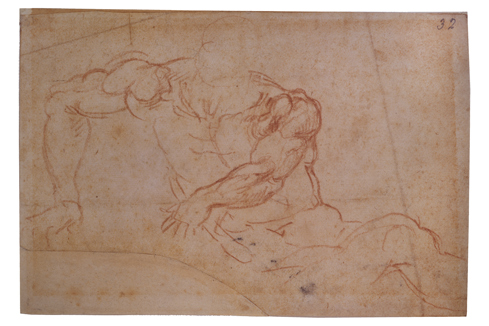Muscarelle scores a coup
Michelangelo exhibit is a U.S. exclusive
Leonardo da Vinci drew his iconic Vitruvian Man to demonstrate the ideal geometric proportions of the human figure. A close look at Michelangelo Buonarroti's equally iconic sculpture David, on the other hand, reveals peculiarly oversized head and hands-features that appear perfectly proportionate when the statue is installed and the observer is looking up at it.
"Michelangelo always said that an artist should keep his compass in his eye, not his hand-because it's the eye that judges," explained Aaron De Groft '88, director of William & Mary's Muscarelle Museum of Art. The Muscarelle scored a coup this spring by being the only U.S. venue this year of a showing of original Michelangelo drawings, a context-filled exploration of the artist as anatomist-architect.
The 12 drawings on loan from the Fondazione Casa Buonarroti in Florence were the core of an exhibit titled Michelangelo: Anatomy as Architecture, curated by De Groft. The exhibit also contained selected 16th-Century prints of ancient sculptures-including a Laocoön that Michelangelo himself saw unearthed from a vineyard-known to influence the artist's concept of human anatomy.
"What we did at the Muscarelle was to run the thread of architecture-as-anatomy through these drawings and these prints," De Groft said. "By doing that, we then illustrate how Michelangelo studied anatomy."
De Groft stressed that the show was a display of the work of experts and primary sources. It included the account of an eyewitness to the unearthing of the Laocoön, for instance, as well as descriptions by contemporaries, such as artist-biographer Giorgio Vasari and a cardinal who worked closely with Michelangelo.
"We're not saying that we're the experts here at the Muscarelle," De Groft said, "but we were able to add two, three, maybe four new things. When you add new findings to Michelangelo studies, that's a very serious thing."
One such addition to Buonarroti scholarship concerns Two Studies for Two Legs, a circa 1520 work long catalogued as a double study of a left leg. However, De Groft points out in the exhibit catalog that the difference in musculature indicates the study is actually of a pair of legs, left and right.
"It's a small addition to scholarship," he said, "but then again, people have been looking at this for 500 years and no one has seen this before." 















